Driven: Renault Megane E-Tech
There are things Renault importer Ateco can’t tell us about the new Megane E-Tech, including when in 2023 it will arrive in Australia and what it will cost. But we do know at this stage is that this Made-in-France EV is a rather good thing.
Thoughtfully engineered, neatly designed, tech-savvy, user-friendly, very refined and good fun to drive, this small EV is a persuasively complete package.
It could compete with everything from the updated Tesla Model 3 and newly-arrived Polestar 2 to the Kia EV6 and Hyundai Ioniq 5.
READ MORE: 10 EVs by 2025, axial flux motors and fresh tech for Renault
READ MORE: New logo, tech, EV focus for Renault: Megane EV due 2022
READ MORE: Renault 5 Prototype revealed, set to be one of 7 new EVs
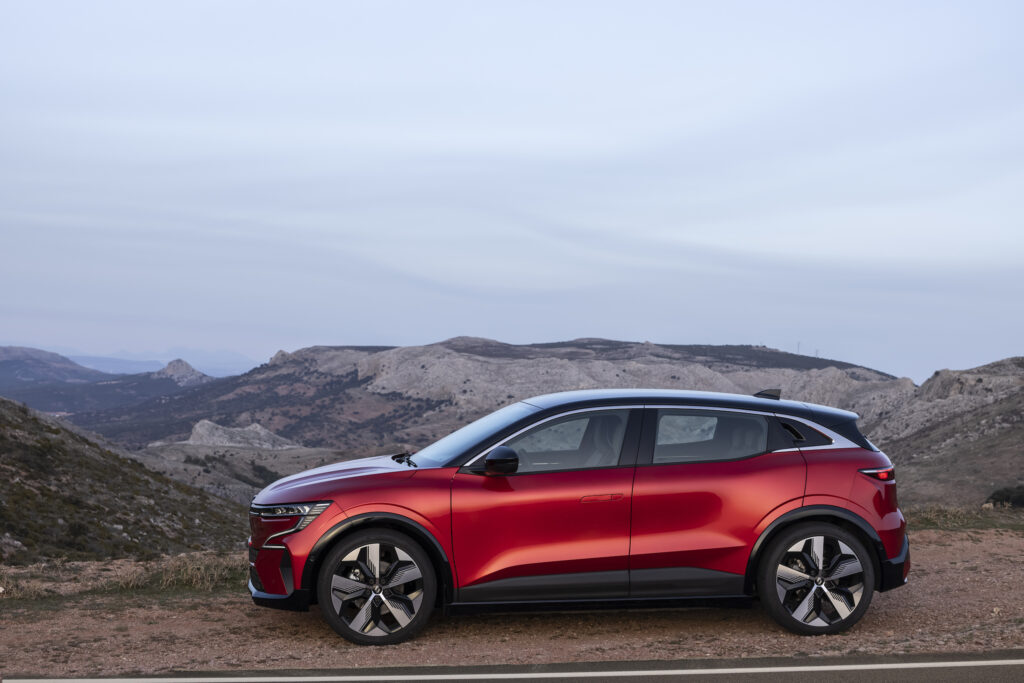
Genre bender
Though the Megane E-Tech is a fraction shorter and a little higher than a VW Golf. The Renault’s exterior design makes it hard to categorise. Taller-than-average small hatch? Lower-than-normal crossover? The choice is yours…
Whatever it is, the Megane E-Tech looks good; long wheelbase, short front and rear overhangs, large-diameter wheels, high-waisted profile, confident curves and neat details.
Renault needs to add ‘E-Tech’ to the EV’s name because it will keep on producing the existing ICE- and hybrid-powered Megane range for another two years or so. Since the mid-1990s, over four model generations, Megane has been the small-car mainstay of the Renault range and the E-Tech will continue in this role.
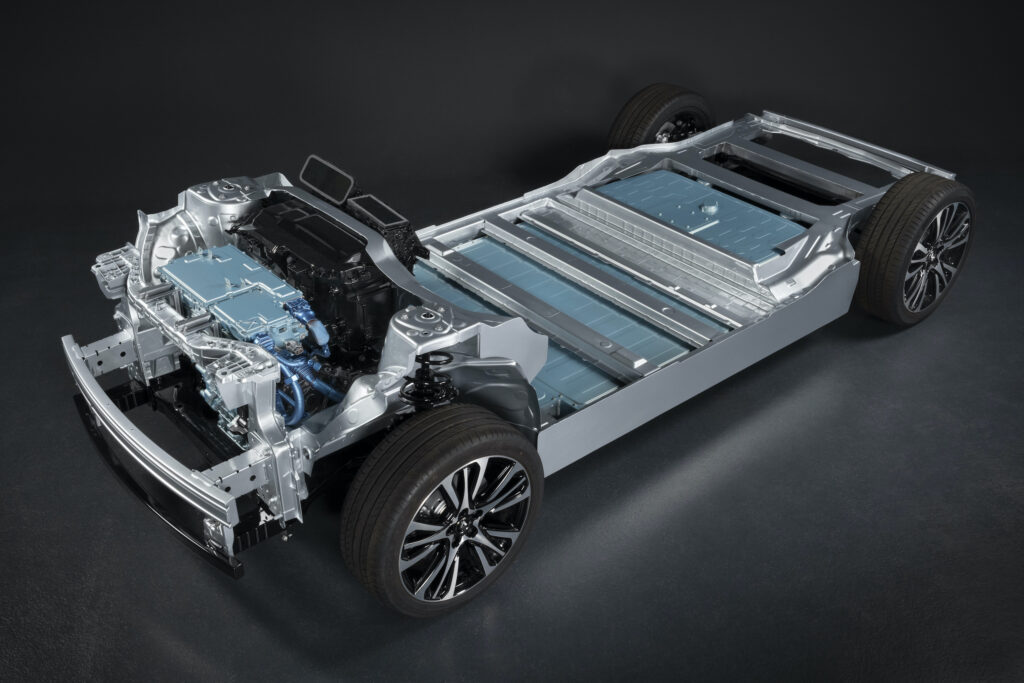
Brand-new base
Being one of the first cars to be based on the Renault-Nissan-Mitsubishi Alliance’s CMF-EV platform (above), the Megane E-Tech brings a number of advances compared to earlier Renault EVs.
Two of them are worthy of mention. At just 11cm thick, the battery packs of the Megane E-Tech are very slim compared to the EV norm. This is enabled partly by the adoption of a space-efficient liquid-cooling system.
The modules of the 400-volt packs are filled with more energy-dense NMC lithium-ion pouch cells from Renault’s long-time supplier LG Chem of Korea.
Unlike many other EV manufacturers, Renault makes its own electric motors. The Megane E-Tech’s motor improves on the unit installed in the big-selling Zoe. It’s oil-cooled, with an eight-pole instead of four-pole rotor. Jointly developed with Nissan, which will also manufacture and use it, the new motor is more powerful, yet weighs less.
Versions producing maximums of 160kW/300Nm and 96kW/250Nm will be installed in the Megane E-Tech range. No rare earth metals, which have a heavy environmental footprint, are needed.
Rare earths are used to make the powerful magnets used in most EV motors, but the Alliance’s motor is an electrically excited synchronous design. This means it instead uses electromagnets made from steel and copper.
The CMF-EV platform is a flexible modular system. This means its size, especially length, can be stretched or squeezed. It’s also designed for dual-motor all-wheel-drive capability, though Renault says the Megane E-Tech will only be produced with a single motor and two-wheel-drive.
And its driven wheels are at the front. CMF-EV is carefully designed to reduce weight and cost, while maximising interior space. The advantages of a front-drive layout were compelling, according to Renault EV chief engineer Jean-Paul Drai.
The new motor, plus its single-speed transmission, inverter and AC charger form a compact assembly that takes up most of the space under the Megane E-Tech’s bonnet. There’s enough room to also accommodate the Renault’s heating, ventilation and air-con unit, a component that in ICE-powered vehicles eats into interior space.
This arrangement saves the cost and weight of the coolant pipes and high-voltage cables that a rear-mounted motor would require, argues Drai. With the Megane E-Tech weighing in at almost 200kg less than VW’s similar-size rear-motor EV, the ID.3, he has a point.
It also means Renault’s designers could take maximum advantage of the Megane E-Tech’s thin battery packs. The benefits, the engineer says, are twofold; interior roominess, but with a lower roofline that reduces aerodynamic drag.
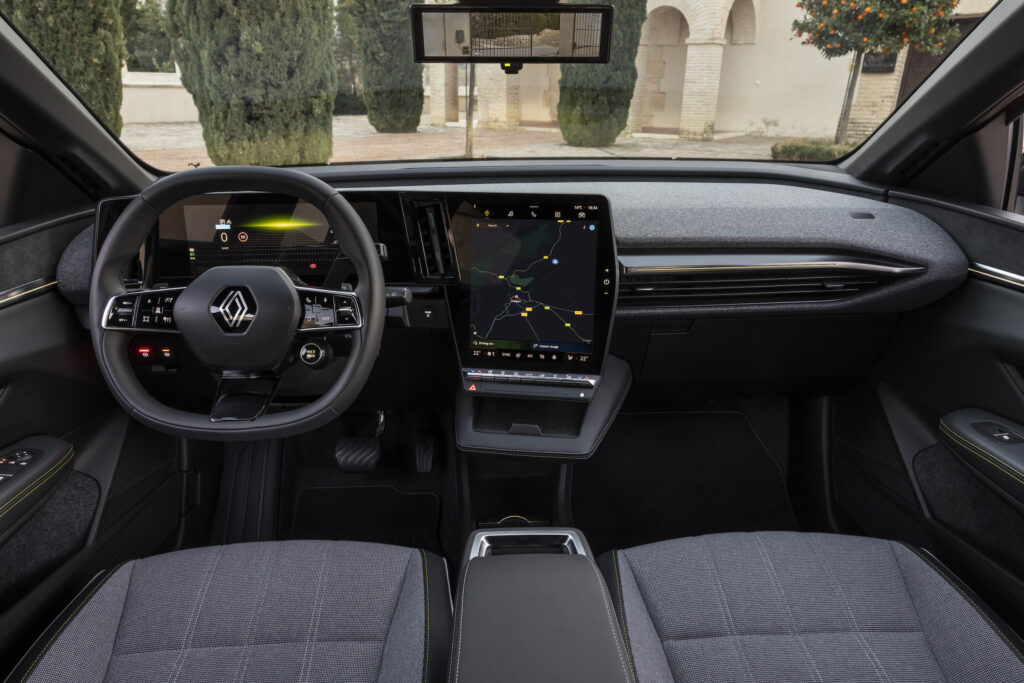
Interior space and tech
While headroom in the three-place rear seat of the Renault is only just enough for a 185cm-tall adult, the low-floored cargo compartment is a pretty impressive 440 litres.
Those in the front seats enjoy a close-up view of Renault’s best interior in many, many years. The slender and stylish dash looks good, but it’s the upside-down L-shaped pair of screens that are the attention grabbers.
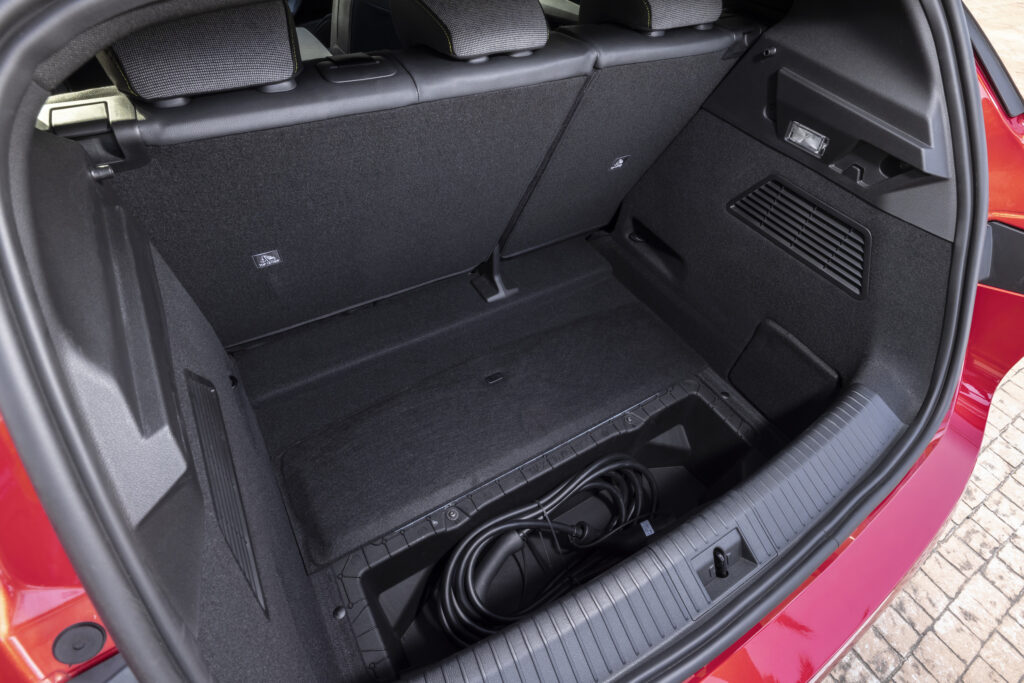
The big portrait-oriented central touchscreen, slightly angled towards the driver, runs Google Automotive Services. It’s not only as familiar and user-friendly as a smartphone, it’s also as just as responsive.
Along the bottom edge of the screen are a row of physical switches for instant and easy adjustment of the climate control system. Below these is a phone tray with inductive charging pad.
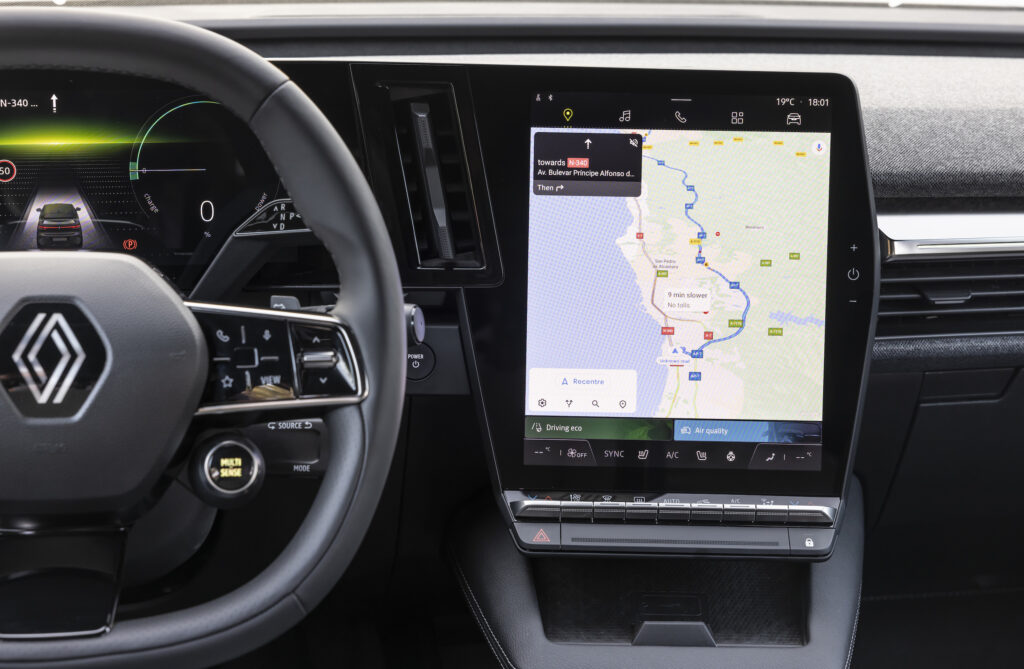
Bluetooth phone pairing is quick and easy. The system is compatible with both iOS and Android devices, so Apple CarPlay works just fine. There are also four USB-C plugs inside the Megane E-Tech. Though the glovebox is tiny, there’s plenty of storage space in the large centre console and doors.
The instrument screen offers a variety of driver-selectable design themes. Controls on the not-exactly-circular new steering wheel’s spokes are intuitive to use. So is the Mercedes-Benz-style transmission selector stalk mounted behind the wheel.
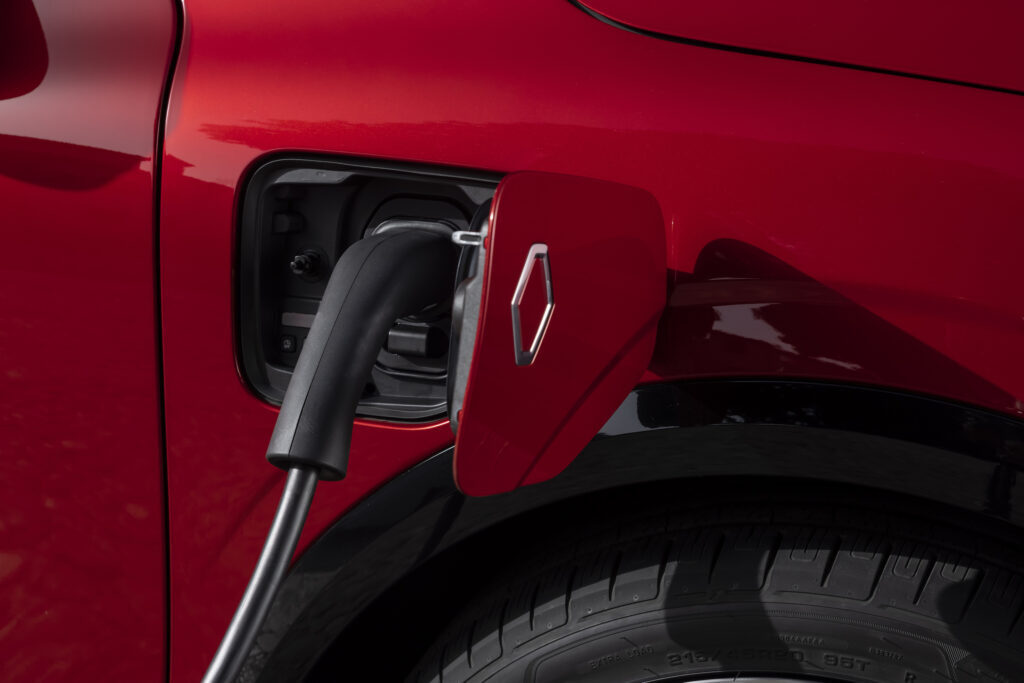
Range and charging
The official WLTP combined-cycle driving ranges are 300km for the small-battery version, while the big-battery version is good for 470km with the 96kW motor and 450km with the 160kW motor. The latter, estimate the experts at EV Database, should be good for an average real-world range of 360km.
All versions are available with a 7kW on-board AC charger. There’s an option to upgrade to a 22kW AC charger. Renault believes this is a big plus in Europe, where there are plenty of 22kW public chargers. These can fully charge the 60kWh Megane E-Tech in around three hours.
All variants with the 60kWh battery get 130kW DC fast charging capability, for a 10 to 80 percent charging time of 30 minutes. The time is similar for the 40kW battery, even though it’s limited to a DC maximum of 85kW.
The Renault’s CCS Combo plug port is behind a flap above the right-front wheel arch.
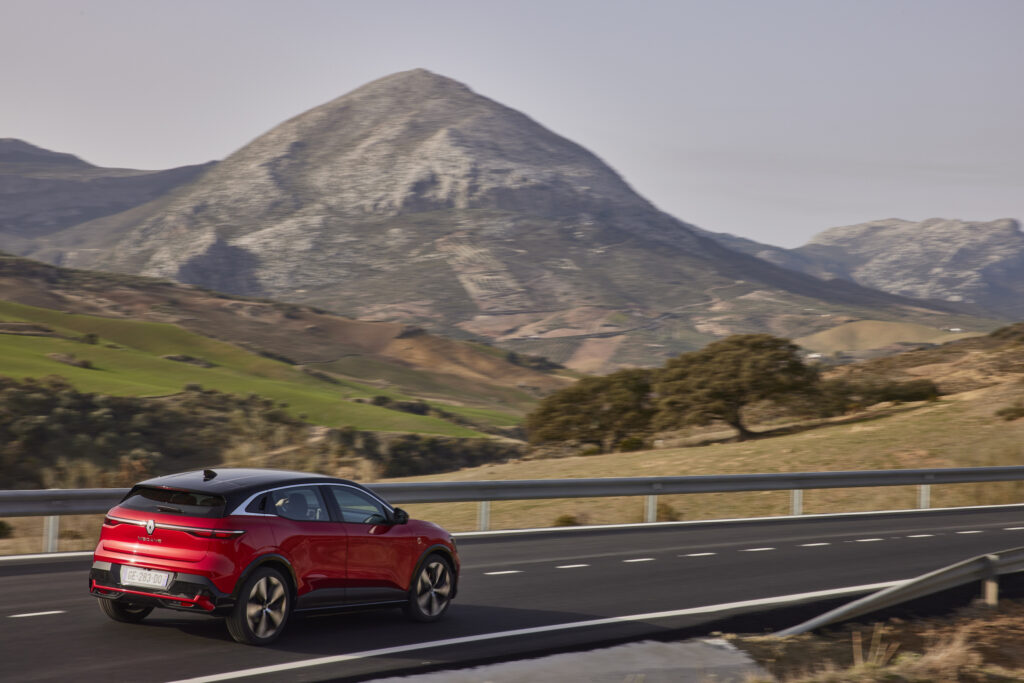
Line-up
Production of the Megane E-Tech at Renault’s EV factory in the north of France is ramping up to full-scale production. While deliveries to European customers will begin in April, right-hand drive cars won’t start rolling off the assembly line until September.
Taking shipping times into account, this means a 2023 Australian launch for the Megane E-Tech. Renault importer Ateco doesn’t know exactly when it will arrive, or the line-up it will offer.
Time for a quick run-through of the range for Europe, then. This is what Ateco will have to choose from…
There are three basic variants in the launch line-up for left-hand drive countries; 160kW motor with 60kWh battery, 96kW motor with 60kWh battery and 96kWh motor with 40kWh battery. Each of these comes in several equipment levels and with at least two options when it comes to charging capability.

Driving the Megane E-Tech
For the international media launch of the Megane E-Tech in the south of Spain Renault brought only top versions. All had the high-power 160kW motor and big 60kWh battery pack, wore 20-inch wheels and came in top Iconic or next-down Techno equipment grades.
How the E-Tech drives with the 96kW motor, the 100kg lighter 40kWh battery pack or smaller and skinnier 18-in wheels are questions that’ll have to wait for another day.
We chose a Techno-grade car, with dash and seats trimmed in good-looking recycled textile instead of top Iconic-level leather. It also had the Optimum Charge package, adding 22kW AC charging capability. Our road-test loop was around 220km, so recharging wasn’t necessary.
Renault engineers say the Megane E-Tech introduces some innovative, and patented, noise-reduction tech, and the car is very quiet and smooth. Subjectively, it’s better than any other small mainstream EV out there.
While the low-speed ride feels on the firm side, the suspension delivers very good comfort and control at higher speeds. Tyre noise levels rise markedly on coarse road surfaces, and there’s noticeable wind noise at motorway speeds, the Megane E-Tech’s all-round comfort and refinement is rather impressive.
It’s pretty corner-capable, too, with some better-than-average hardware. The rear suspension of the CMF-EV platform is independent multilink, not a simpler and cheaper semi-independent torsion beam. And Renault’s chassis engineers chose to make the steering very direct, with only 2.3 turns lock-to-lock.
It feels responsive and lighter on its feet than some EV competitors, one obvious benefit of its low-for-an-EV 1636kg kerb weight. But the Megane E-Tech’s tyres set limits on what the car can do. The Goodyear Efficient Grip 215/45R20 rubber isn’t very wide.
The relatively low level of grip they afford means it’s smart to be prudent with both steering and accelerator inputs if you want to avoid sliding wide of your intended cornering line. Still, up to the point where understeer appears the Megane E-Tech’s dynamic character is very likeable.
There’s some scope to alter its personality, too. Steering wheel paddles allow quick toggling through four different levels of regenerative braking, from none to strong. And the Multi Sense satellite button on the steering wheel cycles through Eco, Comfort and Sport modes, which alter steering weight, motor responsiveness and climate-control system behaviour. A fourth Perso (for personalised) mode allows the driver to mix and match.
How much is it?
With the Australian launch a year or more away the only guide to what it might cost is to take a look at how the Renault is positioned in Europe.
The top Megane E-Tech (Iconic equipment grade, 160kW motor, 60kWh battery pack, 22kW AC charger) is the equivalent of $5000 less than the most basic Tesla Model 3, the $60,900 RWD.
But the high-grade Renaults are also priced a little above equivalent Nissan Leaf e+ models. Australia only sees the topmost versions of the Nissan, which is $60,490 before on-road costs.
So it seems likely the top of the Megane E-Tech range will be in the area of $60,000 to $65,000 when it arrives in 2023.
European prices for the most basic variant of the Renault (96kW motor, 40kWh battery pack, 7kW AC charger) will be a little higher than a similarly basic Leaf. Nissan only sells one high-grade version of the 40kWh Leaf in Australia. It’s priced at $50,000, and Renault importer Ateco could choose to bring in a Megane E-Tech that undercuts this figure. Or not…
What it all points to is the Renault line-up landing here at prices spanning a range from $50,000 to $65,000, but only time will tell.
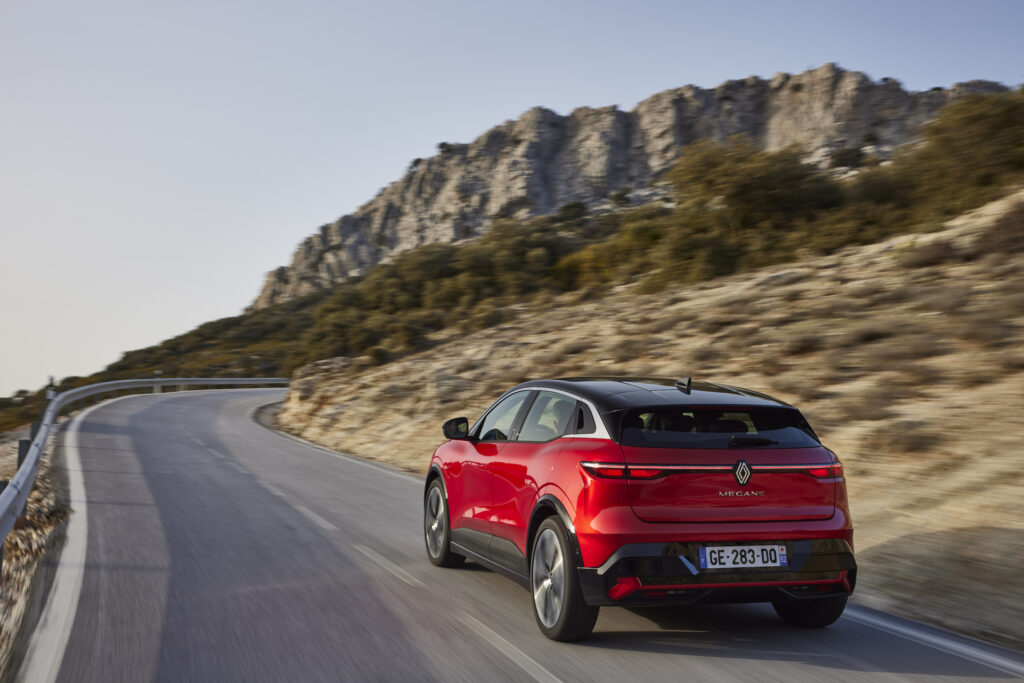
2022 Renault Megane E-Tech Optimum Charge Techno specifications
Price: About $65,000 in Europe
Basics: EV, 5 seats, 5 doors, small hatchback/crossover, FWD
Range: 450km WLTP
Battery capacity: 60kWh
Battery warranty: 8 years/160,000km (guarantee of 70 percent of original battery capacity)
Energy consumption: 16.1kWh/100km WLTP
Motors: 1 front, 160kW/300Nm electrically excited synchronous
AC charging: 22kW, Type 3 plug
DC charging: 130kW, CCS Combo plug
0-100km/h: 7.4 seconds (claimed)

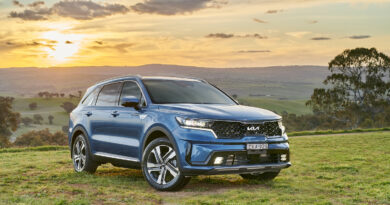


8 pole motor instead of 4 pole motor–!!! OK, more torque but at half the RPM or given AC Hertz. In the old parlance, HP = torque X RPM, , 33,000 foot pounds torque = 1 horsepower. Dont have the young fella patience to do it all in Newton metres and Kw, but what it means is that for an AC motor, you gotta double the Hertz or double the gearing up for the equivalent rpm–the latter by above supposition then halves the torque for which you had previous advantage. The other issue is mass off iron and copper. In good old 3 phase AC 415 volt 50 Hz induction motors parlance, that means halve the speed by doubling the magnetic poles means doubling the mass [pretty much]. That doesnt make sense. Then again the last car Renault made that made sense was the 16TS—about the 1969–then after about 1972 they upgraded that to anonymity.